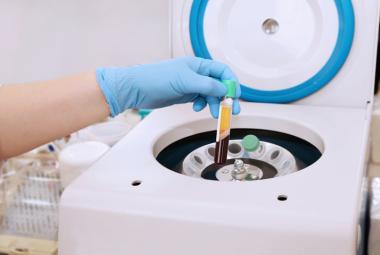G6PD deficiency is a metabolic disorder in which an enzyme in red blood cells, Glucose-6-Phosphate Dehydrogenase, does not work as well as it should. This deficiency makes the blood begins to break down during periods of significant oxidative stress, such as after ingestion of certain drugs and foods. G6PD has also been associated with other enzyme problems that impair the liver’s ability to process and clear bilirubin from the blood.1 G6PD deficiency varies in severity from mild to severe.
The gene that controls G6PD is located on the X-chromosome. Males with only one defective copy will be affected by the disease, while females with only one copy may be variably affected depending on which of their X-chromosomes happens to be active in each red blood cell line. Females with two defective copies are as affected as males. There is currently no technology to diagnose a fetus with G6PD deficiency in the womb, but genetic counseling can help to predict the chances of a fetus being affected by a familial G6PD trait. Pregnant women with a high probability of carrying a G6PD deficient fetus are advised to avoid certain drugs and foods. They are discussed below.
If a breastfeeding mother has been diagnosed with G6PD, she does not need to take any additional steps to safeguard the baby. When a woman has an exacerbation of her disease, the hemoglobin from the damaged red blood cells is broken down into bilirubin. It is believed that bilirubin may diffuse into breastmilk, however, no studies have been performed examining the effect of ingested bilirubin on an infant’s blood levels or clinical outcomes.
If it is the breastfed baby that has G6PD, drugs and foods that can potentially cause hemolysis in a G6PD patient may pass to the baby via the breastmilk. The following drug and food exposures should be avoided:
Dapsone – This is an antibiotic that comes in tablet and cream forms. The oral preparation is probably hazardous for any baby, G6PD deficient or otherwise. Significant amounts enter the breastmilk (up to 22% of the maternal dose) and have been shown to produce hemolytic anemia in G6PD infants.2-4In contrast, topical formulations of dapsone appear to enter the bloodstream in only minimal quantities.5
Nitrofurantoin – This is an antibiotic commonly prescribed to mothers and babies for urinary tract infections. This medication appears to be actively transported into breastmilk. However, the quantity delivered to the breastfed infant is far below the dose prescribed directly to the pediatric population. This medication still has the potential to induce intravascular hemolysis in G6PD infants and may exacerbate neonatal hyperbilirubinemeia by displacing bilirubin from albumin binding sites.4, 6, 7
Phenazopyridine – This is another drug sometimes used for urinary tract irritations. Very little data is available regarding phenazopyridine’s ability to transfer into breastmilk. However, its pharmacological properties suggest that it is likely to show up in milk to a limited degree.8This medication should probably not be used when breastfeeding a G6PD infant.
Primaquine – This is a drug used for preventing malaria. We also know very little about primaquine’s tendency to transfer into breastmilk. It is believed to behave like other antimalarials in the same drug class which are not secreted into breastmilk in clinically relevant amounts.9The use of primaquine in lactating mothers requires careful risk-benefit analysis.
Dimercaprol – This is a chelating agent used to clear the body of certain heavy metals like lead and mercury. Few studies are available on dimercaprol's presence in breastmilk. Its use has declined significantly in the United States since the introduction of succimer. Dimercaprol is definitely risky for G6PD patients in therapeutic quantities, as are the heavy metals mobilized during chelation therapy with this drug.4
Methylene Blue – This is a dye used to treat an emergency situation called methemoglobinemia. It is a very hazardous drug for all infants and breastfeeding should be discontinued for 24 hours after administration of methylene blue.10
Fava Beans – This is the food that inspired G6PD’s original name “Favism.” These beans produce significant oxidative stress in the bloodstream and studies have shown that this effect is transferable in the breastmilk. Avoid these while breastfeeding a G6PD infant.11, 12
Henna – This family of compounds used in skin and hair dyes can induce hemolysis in G6PD individuals via absorption across the skin. Very little data is available about henna’s transfer into breastmilk, but avoidance is still recommended.4
The drugs listed above are the only ones so far demonstrated to cause significant anemia in G6PD deficient individuals. Other related drugs and substances may still be dangerous for breastfeeding mothers but appear to pose no additional danger for G6PD infants.4
Mothers with G6PD should be able to breastfeed their infants without difficulty. It is also fine for a mother to breastfeed her infant if the infant has G6PD. She just needs to avoid certain foods and medications as mentioned above.
-James Abbey, MD
References:
- Kaplan M, Rubaltelli FF, Hammerman C, et al. Conjugated bilirubin in neonates with glucose-6-phosphate dehydrogenase deficiency. The Journal of Pediatrics. May 1996;128(5 Pt 1):695-697.
- Edstein MD, Veenendaal JR, Newman K, Hyslop R. Excretion of chloroquine, dapsone and pyrimethamine in human milk. British Journal of Clinical Pharmacology. Dec 1986;22(6):733-735.
- Sanders SW, Zone JJ, Foltz RL, Tolman KG, Rollins DE. Hemolytic anemia induced by dapsone transmitted through breast milk. Annals of Internal Medicine. Apr 1982;96(4):465-466.
- Youngster I, Arcavi L, Schechmaster R, et al. Medications and glucose-6-phosphate dehydrogenase deficiency: an evidence-based review. Drug Safety. Sep 1 2010;33(9):713-726.
- Pharmaceutical manufacturer prescribing information (Dapsone): Jacobus Pharmaceutical Company; 2011.
- Varsano I, Fischl J, Shochet SB. The excretion of orally ingested nitrofurantoin in human milk. The Journal of Pediatrics. May 1973;82(5):886-887.
- Gerk PM, Kuhn RJ, Desai NS, McNamara PJ. Active transport of nitrofurantoin into human milk. Pharmacotherapy. Jun 2001;21(6):669-675.
- Pharmaceutical manufacturer prescribing information (phenazopyridine): Contract Pharmacol Corp; 2012.
- Recommendations for the prevention of malaria among travelers. MMWR Recommendations and Reports. Mar 9 1990;39(RR-3):1-10.
- Peter C, Hongwan D, Kupfer A, Lauterburg BH. Pharmacokinetics and organ distribution of intravenous and oral methylene blue. European Journal of Clinical Pharmacology. Jun 2000;56(3):247-250.
- Kattamis C. Favism in breast-fed infants. Archives of Disease in Childhood. Oct 1971;46(249):741.
- Kaplan M, Vreman HJ, Hammerman C, Schimmel MS, Abrahamov A, Stevenson DK. Favism by proxy in nursing glucose-6-phosphate dehydrogenase-deficient neonates. Journal of Perinatology. Nov-Dec 1998;18(6 Pt 1):477-479.







